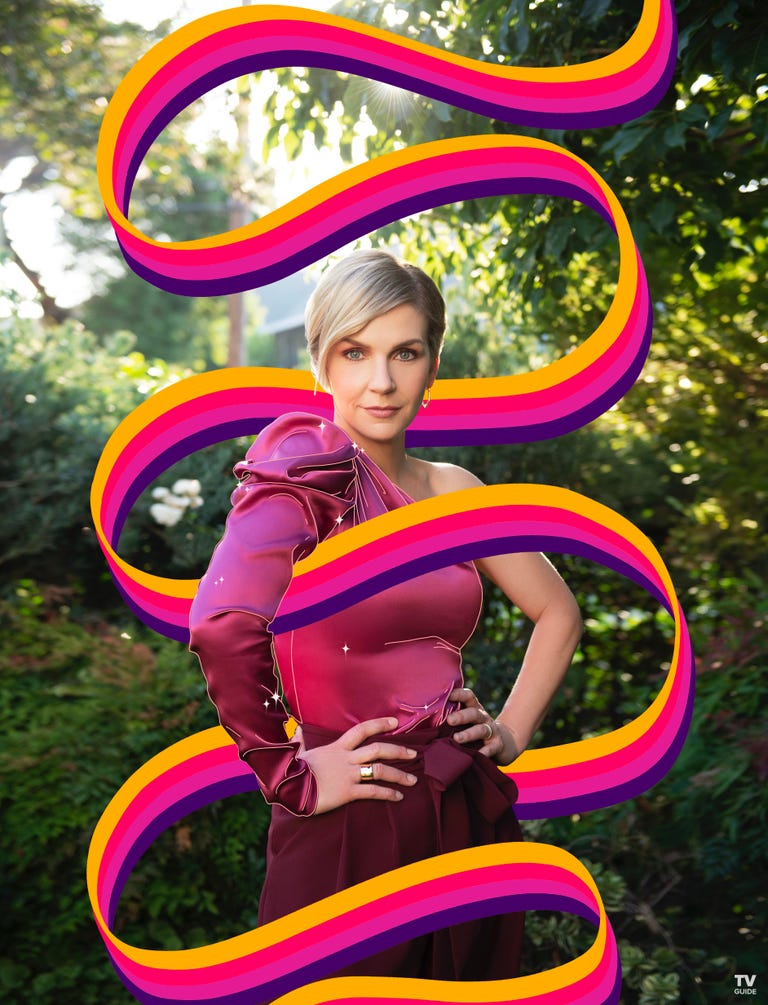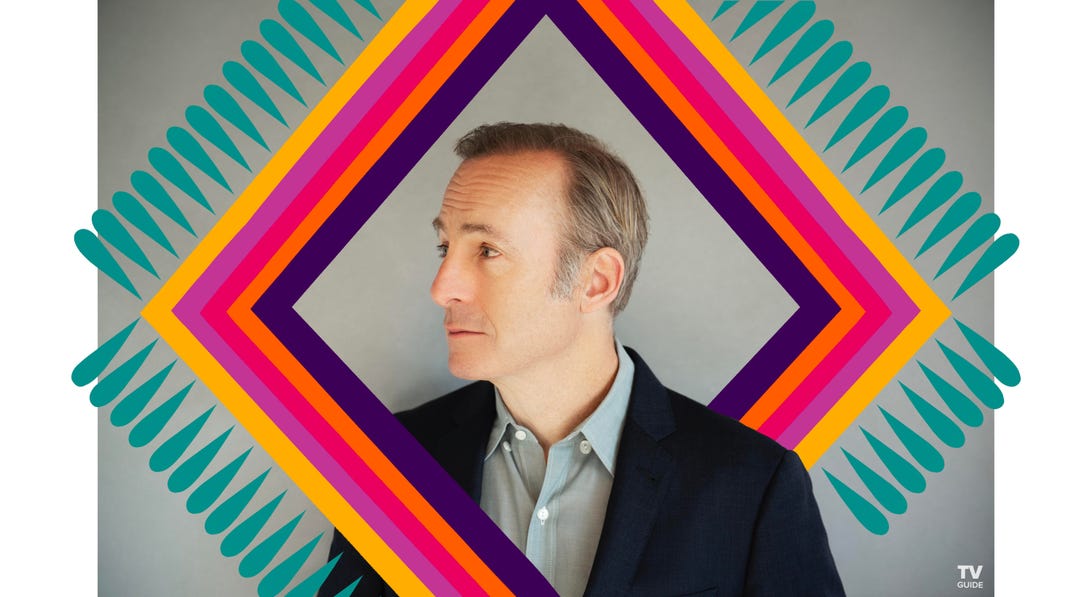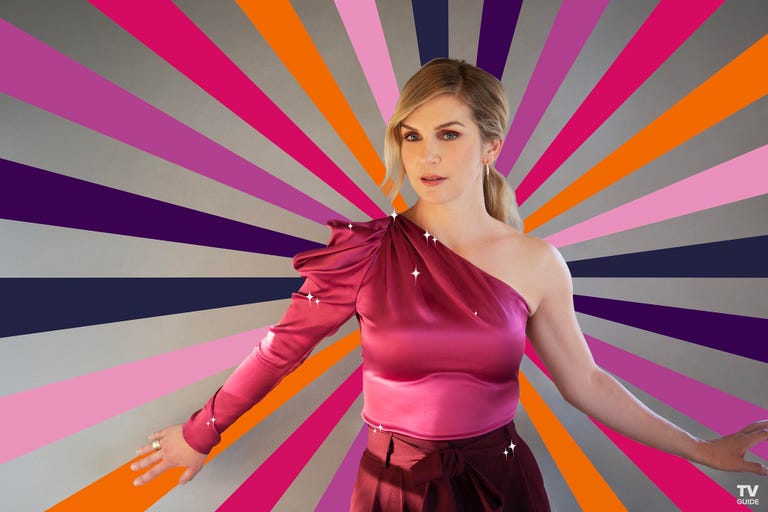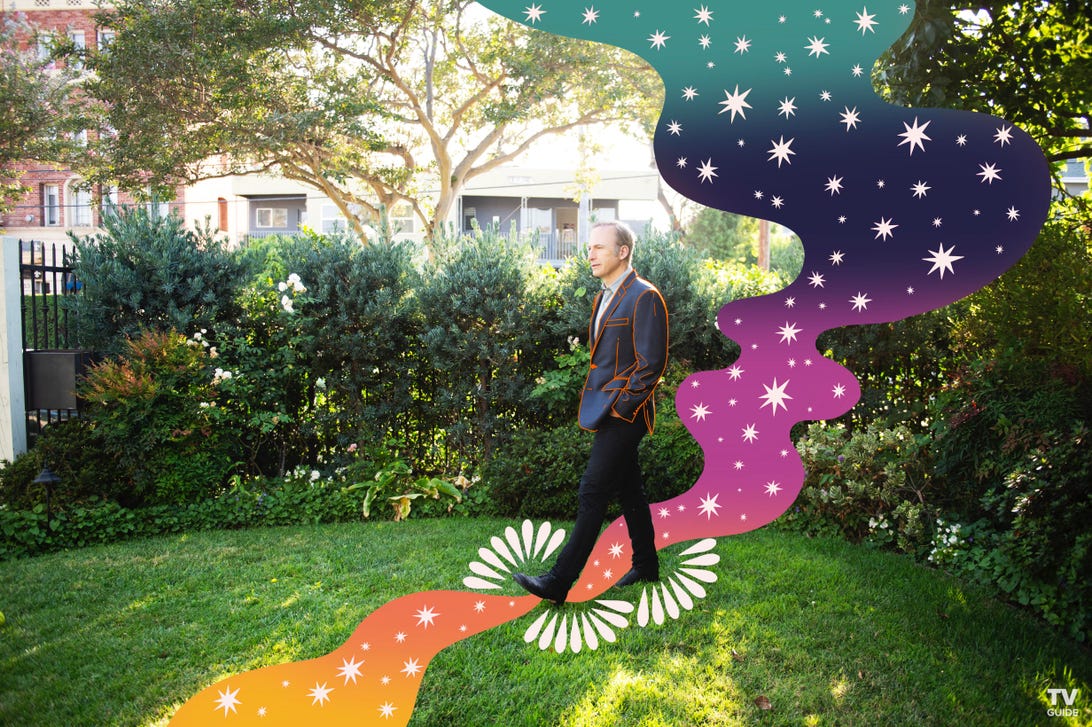
Better Call Saul Is the Best Show on TV Right Now
AMC's Breaking Bad prequel is even better than its predecessor. The cast and creators of Better Call Saul chronicle its unstoppable ascent.
Vince Gilligan cannot emphasize it enough: He thought making Better Call Saul would be easier. The devastatingly good Breaking Bad prequel charts the slow moral descent of Jimmy McGill (Bob Odenkirk), a scrappy hustler trying to go legit, as he morphs into the crooked criminal lawyer known as Saul Goodman. It seemed at first like a lighter angle on the high-stakes world of Breaking Bad, but the backstory of a man who was introduced as a colorful side character has evolved into something far more tragic than Gilligan and co-creator Peter Gould could have expected — and far more complicated.

"Our early days, we said to ourselves, 'This is going to be so easy.' Because we know where it ends up. And that just made it harder," Gilligan told TV Guide. Breaking Bad, for all of its careful plotting, could have taken its characters anywhere. ("If we'd just gotten absolutely sick of Walter White, we could have killed him off in Season 2 and then gone on with just Jesse, I guess," Gilligan shrugged.) But Better Call Saul is naturally constricted by its predecessor, which looms ahead in the timeline of the series. Add on the fact that it's one of the most meticulously slow shows out there and Saul becomes an even more unlikely success.
And yet Better Call Saul has become the best show on TV by the length of a desert horizon, a patient but gripping drama unlike anything else out there, including its predecessor. For much of the series, the plot has been split in two: half Jimmy's exploits with the law (said Patrick Fabian, who plays Howard Hamlin, "The show for me is about some lawyers with emotional problems") and half jack-of-all-trades Mike Ehrmantraut (Jonathan Banks) taking odd jobs in Albuquerque's criminal underworld. Each side has its own unique thrills; Saul can spin the most granular legal disputes into sweeping epics or zero in on cartel business until it's suffocating. But the AMC drama, which premiered in 2015, has gotten better by the season as its two worlds have slowly bled into one another. Season 5, the show's penultimate outing, was its most stunning achievement yet, an expertly executed series of chain reactions that settled one of television's great debates: Yes, Better Call Saul is even better than Breaking Bad.

Star Bob Odenkirk is well aware of how much Saul has asked of its viewers to get to this point. "The degree to which Better Call Saul trusts its audience to care on a deep level about these people is a trust exercise that I would hesitate to do on my own," Odenkirk said. He credits Breaking Bad, which taught fans that their patience and attention to detail would be rewarded, for amassing enough goodwill to pave the way for such an idiosyncratic show. Saul moves at its own pace, in part because knowing so much of what's coming changes the focus of the show.
The 100 Best Shows on TV Right Now
Better Call Saul is an antidote to TV's love of unpredictability. To watch it is to seek out the pain of knowing something bad is coming and caring so much anyway that it feels like a surprise. "Our theory was that how things happen is even more interesting than what happens," said showrunner Peter Gould. "You can synopsize anybody's life by saying, 'She was born, and then she died.' But it's the experience of it." To maximize that experience, Gould and Gilligan made the Jimmy McGill of this prequel as different from Saul as they could. "The Saul Goodman in Breaking Bad was fun to watch, but not because he was inherently a good, likable person you want to be with," said Odenkirk. "You can watch him like you watch a car wreck. You can't turn away. But you don't really cheer for him." In Jimmy, a sympathetic scammer who bootstrapped his way through law school, the creators found someone fans could root for, however masochistically.
Jimmy's painful evolution into Saul was powered by his frustrated love for his older brother Chuck (Michael McKean), a formidable lawyer laid low by a strange illness, an apparent sensitivity to electricity. Gould and Gilligan had initially envisioned him as a tragic figure, but McKean imbued the character with such pride that they were inspired to turn Chuck into Jimmy's main antagonist. Gould recalled how his view of the character was changed after watching McKean on set early in the show's production: "I remember going back to the writers' room, and we asked, 'What does this guy who is so brilliant think of having Slippin' Jimmy for a brother?'"
Answering that question led the entire series to what Gould said was a more dramatic place than he and Gilligan had first anticipated. Chuck's lack of faith in Jimmy became a self-fulfilling prophecy, as Jimmy fought his con artist tendencies in order to impress his brother and then gave in to them when Chuck still refused to take him seriously. "The unspoken line from Jimmy is, 'I've become a lawyer. What can I do to make you treat me like I'm not just a pain in the ass?'" said McKean. "And even if he said it out loud, it would be like yodeling in a canyon." Chuck's death at the end of the third season closed the door on Jimmy's attempts to play by the rules, eventually leading him to change his professional name to Saul Goodman to escape his brother's shadow.

For a show with so much of its timeline already dictated, Better Call Saul has stayed impressively flexible in its storytelling. While the cast credits the show's sharp writing, the creators credit the powerhouse cast for bringing out unexpected new dimensions of their characters. That willingness to let the characters guide the story led to the rise of Kim Wexler (Rhea Seehorn), Jimmy's loyal friend and now wife, who has emerged as not only the best character on the show but the best character on TV. Taking their cues from Seehorn's perfectly calibrated performance — what Gould described as "her poker face, and her ability to hold things in while also being able to [let the audience] see them" — the writers uncovered a thrilling darkness in Kim that would alter the series.
Introduced as a tireless, by-the-book lawyer at Chuck's firm whose skills were overlooked by the men above her, Kim could have been simply a straight-edged counterpoint to Jimmy's rule bending. But when Seehorn let Kim smile at one of Jimmy's scams early in the first season, she tapped into what would become a powerful rebellious streak in her character. The writers discovered that Kim's sometimes tentative attraction to running cons brought her and Jimmy together as a couple. "It gives the two of them a spark, and the truth is that that spark leads them down a dark path," Gould said.
By the fifth season finale, it was Kim's turn to shock Jimmy when she proposed that they frame their former boss, Howard, for something terrible in order to close an old case, which would help the residents of a retirement home and also provide her and Jimmy with a hefty joint payoff. Her chillingly clear-eyed scheme revealed a fascinating new side to Kim's righteousness. "That sort of Robin Hood complex that she's had from the beginning always seemed just a little bit dangerous to me," Seehorn said. "She has continually tried to find a way to put her finger on the scales of justice just a little bit to make the right person win."
How Rhea Seehorn Became Better Call Saul's Greatest Showman
Seehorn didn't want to put too fine a point, even in the episode, on exactly how serious Kim is or where her motive falls between altruism and revenge. "She's being quite menacing. How much of it is sincere? How much of it is playful?" Seehorn wondered. She posited that Kim could be revealing another side to herself as retaliation to Jimmy for making Saul Goodman a kind of "third party" in their relationship. "You can see how much it's been building in her that she cannot stand to be told how to feel. She can't stand to be told what she is or is not capable of." By shooting finger guns at a rattled Jimmy, Kim reversed the couple's roles in the Season 4 finale, when he stunned her by deciding to practice law under a new name. Kim has another side to her, too, and Better Call Saul is the story of her transformation as much as it has been Jimmy's.

"The mystery at the core of the show — which for a long time was, 'Who is Saul Goodman? Who is Jimmy McGill?' — I think to a great extent that's been answered," Odenkirk said. "There's still a lot of fun in watching his story play out. But I think the mystery now at the core of the show is, 'Who is Kim Wexler?'"
As Kim has changed, so has the conversation around her fate. Fans have long been worried about her survival, as she's one of the few characters in the show whose future isn't explained by Breaking Bad. Around Chuck's death, Seehorn said she started to think there may be fates sadder than dying for Kim. "Her being in jail, her having to run, her altering herself or revealing herself to be so different that she actually could stay and tolerate what he does [as Saul] is equally tragic," she observed. It's not what happens to her that keeps viewers up at night anymore. It's what Kim could do.
"I don't think anybody's going to corrupt her, but she could corrupt herself," Gould said.
Kim put herself "in the game" in the fifth season when she met with — and later verbally eviscerated — cartel enforcer Lalo Salamanca (Tony Dalton) to protect Jimmy. Since his introduction late in Season 4, Lalo has gone a long way toward finally merging the two worlds of Better Call Saul by the sheer force of his chaotic magnetism. The standout Season 5 episode "Bagman" cemented Saul Goodman as a "friend of the cartel" when Lalo sent him out to the desert to collect his $7 million bail, a mission that would have killed him if Mike hadn't stepped in to protect Gus Fring's (Giancarlo Esposito) interests by saving Jimmy. Esposito applauded the episode for hammering home the danger the cartel poses, not only to the characters' lives but to their relationships. "It allowed us to really get inside both of those characters in a different way, and for us to feel the edginess on the cartel's reach," he said.

The intense, cinematic hour, directed by Gilligan and written by Gordon Smith, was a massive accomplishment that Gilligan was characteristically self-effacing about. "If I'd been in the writers' room I would have said, 'No, this is way too hard,'" said Gilligan. "'You've got to have a scene by the pool somewhere.'" Filmed mostly on the To'Hajiilee Indian Reservation, about two hours outside Albuquerque, in 100-plus degree heat, the episode was an endurance test for its cast and crew. Banks laughingly called it "torturous," Odenkirk "brutal." As Jimmy, Odenkirk also spent most of the shoot lugging a pair of duffel bags meant to be full of $7 million in cash, which prop master Mark Hansen calculated would have weighed over 75 pounds each in reality. Odenkirk was set up with prop bags that generally weighed between 15 and 30 pounds each, though according to Gilligan, he was down to push himself harder. "Bob was game. He said, 'I'll do it,'" Gilligan remembered. "I said, 'No, man. Gotta have an actor for day two.'"
Celebrate Better Call Saul With These Exclusive 100 Best Shows Portraits
On screen, the ordeal brought out a perverse dignity in Jimmy, tying back to the character's origins. "When Vince and I first met Bob to talk about [Better Call Saul], one of the things he said, I seem to remember, is, 'Guys, beat me up. I want to be as uncomfortable as possible,'" Gould recalled. He was reminded of Odenkirk's first appearance as Saul in Breaking Bad, which was filmed during a sandstorm. "It looked like Mad Max. And Bob loved it. He likes discomfort," said Gould. "So one of the things we learned was to write to him as a character; he loves scenes where he's in a dumpster, or he's out in the desert and his clothes are falling apart and his shoes are falling apart. Somehow when he has those moments, you start seeing what the character is made of." The showrunner highlighted the scene at the end of "Bagman" when a defeated Jimmy gives in and drinks his own urine. "When we pitched it I always kind of giggled and thought it was funny, in a way. But Bob brought a sense of unstoppability, a sense of grit. He reminded me of Humphrey Bogart as Fred C. Dobbs in The Treasure of the Sierra Madre."

Jimmy emerged from the desert changed, and not only because his unsavory alliances were sealed. The experience killed his illusion that he could lock Saul Goodman away from his personal life. Letting go of that fantasy, Odenkirk said, wasn't easy for Jimmy to do. "He just made this choice, and he got to enjoy it for like no time at all," he said. "You'd think he'd get a year or two of being Saul Goodman and having a blast and making money and being disconnected from his ethical compromises. But no. Right away, he's in the sh-- from Lalo."
Jimmy never imagined when he started practicing as Saul that he would wind up fighting for his life in the desert, but the brilliance and the tragedy of Better Call Saul is how intricately it traps its characters in the consequences of their choices. "I love watching what it says about humanity and the slow disintegrations and small little choices that lead us to where we go. It's usually not something big. It's usually a series of things, a crooked line," said Fabian. Or, as Seehorn put it, "Not everybody sets out to jump off a cliff. They just got closer and closer to it." No prequel has ever been smarter about what it means to be a prequel than Saul is. As the writers wrestle with the inescapable Breaking Bad timeline, the fear of a predetermined fate is baked into the story.
For Banks, whose character is tormented by the choices he made as a cop, the theme is a "monumentally tragic" one. "Mike has to live with himself, and that's not an easy thing. Mike doesn't forgive himself," Banks said. That gives him an understanding with soulful cartel member Nacho Varga (Michael Mando), who's caught under Gus' thumb even more than Mike is. But while Mike's cruel fate is made clear in Breaking Bad, Nacho's ending remains open, and Mando holds out hope that his character will find a way out of the cartel life. "I used to think it's a story of redemption until the end of this season, and then I realized maybe it's a story of emancipation. Maybe it's a story of liberation — of liberation from oneself, from everyone that's pulling at you."

In order to free himself, Nacho will have to get past Lalo, who heads into the sixth and final season gunning for everyone after Nacho betrayed him for Gus. "We've got this really smart guy who is a bit of a wild card, and Gus has a problem with wild cards," Esposito said of Lalo. And now that Kim and Lalo have faced off, Esposito is hoping the next season will finally bring Kim into Gus' orbit. "It would be so wonderful to have an opportunity for Saul and Kim to need help," he speculated, "and to be forced into a position where they have to go and get advice from Gus." The scenario doesn't sound too far-fetched given that Dalton doesn't believe Lalo has let go of being put in his place by Kim, either. The actor expects that the next time Lalo sees Kim and Jimmy, he won't back down. "That whole 'tell me again' scene is going to look like a little Disney park ride," he teased.
One showdown that might not be in the cards is another flashback appearance from Chuck, if only because McKean doesn't want to dilute his power. "I think maybe the essence of a really successful haunting is not to make too many in-person appearances," McKean said. But Chuck continues to loom over the story in other ways, haunting Jimmy by proxy through Howard and driving him deeper into the pattern of self-destruction that makes him Saul Goodman. "I was raised Catholic, and connecting to a deep feeling of shame is fairly easy for me to do," Odenkirk said. But Odenkirk has less sympathy for Saul, for reasons that neatly sum up the show: "When you decide to indulge your worst urges, you're a fool if you don't think that's going to backfire eventually. It always does. You're building your house on the worst foundation you've got, and over time it will collapse."

As Breaking Bad fans know, Jimmy's house will collapse under the weight of everything he does as Saul, forcing him to go into hiding as Gene Tacovic, the skittish Cinnabon manager whose black-and-white flash-forwards have opened each season. "Jimmy's story isn't done. He could choose to be a different person from this point on," noted Odenkirk, who anticipates spending more time with Gene in the final season. Jimmy's potential to go anywhere as Gene represents the secret to Better Call Saul's success, finding windows of possibility that completely change a story that looked like it was already set in stone.
"I love the story of someone who has done a lot of bad things nonetheless redeeming themselves," Gilligan said. But Gould took a harder look at everything on Jimmy's conscience. "I think he has a moral burden for everything that Walter White does," he commented. "Can he redeem himself after all that?" To Gould, what damns Jimmy is also what makes his story so tragic: "Underneath all the nasty things he's done — and it makes it sadder to me — there's still Jimmy McGill who we first met, who just wanted his place in the world."
There was a time when the intimate scale of Jimmy's moral downfall may have made Better Call Saul look like a smaller story than Breaking Bad, but the show has taken a premise that could have been a hard sell and made it unmissable with all the showmanship of Saul Goodman himself.
"I see now that this was the bolder experiment," said Gilligan.
Art Direction and Photography: Jessie Cowan
Illustration: Antonia Figueiredo
Lettering Artist and Layout: LEBASSIS
Photo Assistant: Keith Coleman
Hair: Matthew Collins
Makeup: Kayleen McAdams
Stylist: Sydney Lopez
Retoucher: Rachel Koll
Video Producers: Aaron Segura, Sadie Gennis, Semhar Debessai
